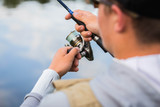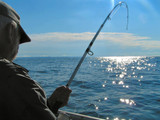How Do Trolling Motors Make Fishing Easier?
Whether you are rowing, paddling, or listening to the constant hum of a gas motor, traditional boat fishing can be physically and mentally demanding. Modern electric trolling motors offer a superior alternative to conventional boating with precise positioning, stealthy maneuvers, and easy access to shallow water.
Find out how trolling motors make fishing easier by enabling effortless navigation in the water, resulting in a more enjoyable outing.
Advantages of Using Trolling Motors in Fishing
A successful fishing trip depends on your angling skills and locating the perfect spot to ensure you don’t scare off nearby fish. Equipping your boat with a trolling motor provides you with numerous benefits over traditional propulsion techniques, thanks to its quiet operation and compatibility with fish-finding technologies, among other advantages:
Better Maneuverability
Trolling motors offer superior steering precision, allowing you to navigate tight spaces like channels and inlets easily. Rather than relying on a rudder, a trolling motor maneuvers by redirecting the propeller’s thrust to turn with a 360° directional adjustment.
A trolling motor’s slow speeds also help you steer your boat more effectively using less forward momentum. Slower speeds let you crab sideways to keep your bait in strike zones near cover, quickly react to bites, or thread through dense floating vegetation.
Stealth and Silence
The stealthy and silent movement of trolling motors can help avoid spooking fish in shallow waters, especially species that are easily startled, like trout or carp. The gentle hum of an electric trolling motor causes minimal disturbance to the water’s surface compared to the louder sounds produced by oars, paddles, or an outboard motor.
Access to Shallow Water
Trolling motors excel at accessing ultra-shallow waters that are impractical for larger outboard engines. With long, vertical shafts positioning the propeller deeper in the water column while keeping the motor head above the surface, these motors allow you to explore locations with water depths as shallow as 2 or 3 feet.
A trolling motor means finding the ideal location in shallow backwaters and target areas where big fish congregate while preventing propeller damage from scraping the river or lake bottom. The narrow profile and small prop also create minimal draft, helping you navigate narrow tributaries and the edges of floating structures like docks, buoys, and weed beds that hold bass, pike, muskies, and panfish.
Hands-Free Operation
Modern trolling motors offer hands-free operation by integrating technologies such as Minn Kota’s i-Pilot, foot pedals, wireless remotes, smartphone connectivity, and autopilot mode. These features make it possible to cast, work with bait, land fish, and handle other gear simultaneously.
Tech Integration
Trolling motors with integrated GPS and autopilot capabilities allow you to navigate to specific coordinates automatically and maintain a steady course. This lets you focus more on fishing and less on positioning.
The Spot-Lock function acts as an electronic anchor, keeping your boat stationary over fishing spots, ideal for targeting areas like drop-offs or submerged structures. Smartphone integration offers enhanced features, such as motor diagnostics, battery status, and route planning, to simplify your fishing experience.
Environmental Friendliness
With fewer pollutants and silent operation, these electric motors offer a quieter and greener option than traditional gas-powered engines. The eco-friendly features of a trolling motor reduce the impact of recreational fishing on aquatic ecosystems while also ensuring that you enjoy a more tranquil, relaxing fishing experience.
How Do Trolling Motors Work?
While trolling motor designs vary across brands, models, and power levels, most outboard trolling motors operate on the same basic principles. Understanding how these motors function can help you select the optimal trolling motor for your needs and use it effectively.
Thrust and Power
Like all boat motors, an electric trolling motor’s job is to supply thrust to move the vessel through the water. Thrust is measured in pounds (lbs) or kilograms (kg), indicating the amount of forward (or reverse) force the propeller exerts.
Higher weights equate to more thrust to move larger, heavier boats. Lower thrust trolling motors around 30 to 50 lbs. are ideal for small boats and kayaks, while larger bass boats and bay boats require 55 to 112 lb. motors.
This forward propulsion comes from a submerged propeller spun by an electric motor. While early trolling motors used a 12v or 24v DC electric system, most modern motors run on a 24v or 36v DC system. Higher voltage allows more power from smaller, lighter motors.
Power is transmitted from the electric motor to the propeller using a direct drive system or a geared system. Direct drive is simple and efficient but limits speed variability, while geared systems allow different speed configurations but sap some power through friction losses.
Control Systems
Trolling motors provide various control systems depending on your preference, including hand, foot, remote, and smartphone controls.
- Hand controls. Basic transom mount motors feature a handle to turn and point the motor manually. The further the handle gets turned, the more the motor pivots and directs thrust to one side, turning the boat.
Higher-end bow mount trolling motors provide a more responsive steering and speed control with an adjustable hand control that can be mounted in multiple positions for operation anywhere in the boat.
Pushing left or right signals the motor to redirect thrust and turn the boat while twisting forward or back varies motor speed. - Foot pedal. Popular on bass boats, the foot pedal motors use a tilting foot pedal control. You need to press the top or bottom of the pedal to tip the motor and direct the thrust. The middle position keeps the motor straight, and sliding the pedal forward or back adjusts motor speed.
- Wireless remote. Remote-controlled trolling motors with wireless handheld units are the most advanced option. Wireless control means you can walk around the boat to cast and land fish while independently controlling direction and speed from the remote.
Precision GPS anchor modes allow the motor to maintain an electronically locked position, while remote capability maximizes fishing freedom and control. - Smartphone apps. Many trolling motor models can now also integrate with Bluetooth-enabled smartphone apps for wireless control to improve convenience and accessibility on the water.
Selecting the Right Trolling Motor for Your Fishing Needs
With a wide variety of trolling motors from top manufacturers like Minn Kota, Garmin, and MotorGuide, choosing the optimal model for your boat and fishing style is critical. Consider the following factors when selecting a trolling motor:
Vessel Size and Weight
Determine the required thrust based on your boat’s size and weight, typically 30 to 120 lbs. Generally, you need around 2 lbs. of thrust for every 100 lbs. of boat weight.
Measure your boat’s full weight and dimensions at maximum capacity, including the beam width, transom height, and gunwale height. Choose a mounting bracket and shaft length that fits your model. Ensure the shaft length allows at least 12” to be submerged below the water line. Also, account for passengers, gear, and potential future accessories to prevent underpowered issues.
Fishing Locations
Your fishing spots and angling style also influence your trolling motor specifications. Analyze the size, depth ranges, and conditions of the lakes, rivers, or offshore waters you frequently visit. For shallow, rocky creeks under 5’ deep, opt for the longest available shafts, up to 60”, for sufficient clearance and tilt angles.
Exposed large lakes need higher peak thrust levels, between 70-112 lbs., to power through winds and choppy waters. If you prefer saltwater fishing, you’ll need a trolling motor with corrosion-resistant construction to withstand moisture and salt spray.
Battery Type
Confirm full compatibility with your battery source to tap optimal power. While deep-cycle marine batteries are common, lithium alternatives offer more stored energy at lighter weights.
Review charging needs, ideal amperages drawn, and maintenance requirements. This ensures the motor optimizes rather than drains battery capacity during full-day fishing trips.
Wireless Connectivity
Evaluate whether onboard wireless and smart technology integrates with your existing fishing electronics. Many higher-end trolling motors now provide Bluetooth smartphone control, remote steering via a smartwatch app, and networking with fish finders.
Built-in GPS also enables advanced autopilot functions like cruise control routing, saving specific waypoints, and anchor lock position holding even in current and wind. The latest software integrations enhance control and location marking convenience without manually placing physical markers.
To ensure you find the best trolling motor for your needs, FISH307 offers a variety of options in different ranges:
- Garmin Force. Transform your fishing experience with the Garmin Force freshwater trolling motor. This highly efficient 50" powerhouse provides precise control and responsiveness with ultra-high-definition scanning sonar and a wireless foot pedal, ensuring clear visibility of fish and structures.
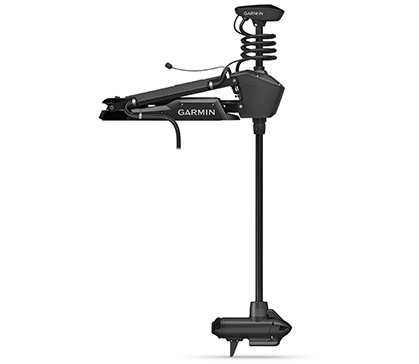
- Minn Kota Riptide Instinct Quest. Explore the saltwater confidently with the Minn Kota Riptide Instinct Quest. This 24/36V dual-voltage brushless motor offers unmatched performance, featuring Auto Stow & Deploy for seamless operation via wireless remote, One-Boat Network App, or Humminbird fish finder.
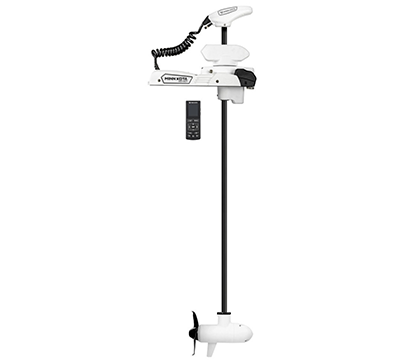
- MotorGuide X3. The MotorGuide X3 trolling motor is designed for anglers seeking peak performance in the 40- to 70-lb. thrust range. With a dual cable pull-pull steering system, Variable Ratio Technology, and an aircraft-grade aluminum mount, the X3 offers the best-in-class steering performance.
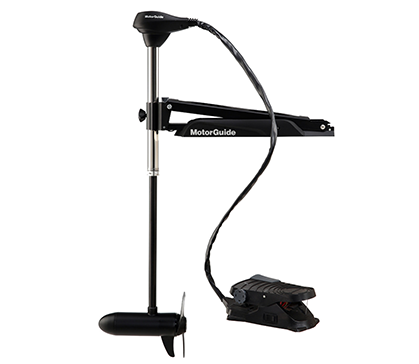
- Minn Kota Ulterra 80. Experience advanced wireless connectivity with the Minn Kota Ulterra 80 trolling motor. With Auto Stow/Deploy, Power Trim, and MEGA Down Imaging, this motor ensures durability and toughness. Its programmable foot pedal, redesigned motor, and advanced GPS functionality ensure peak performance and control on the water.
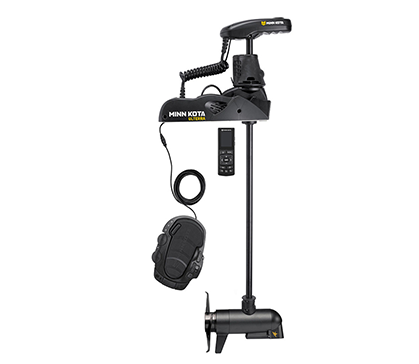
Installation and Maintenance of Trolling Motors
If you are new to trolling motors, properly installing and maintaining them ensures smooth, trouble-free operation. The following key installation steps and maintenance tips will help you get the most out of your trolling motor:
Installing a Trolling Motor
Trolling motor installation includes mounting the motor, connecting it to a power source, and testing everything before hitting the water. Basic installation steps include:
- Select an appropriate location on the boat’s transom or bow to mount the motor.
- Use marine-grade stainless steel bolts to firmly fasten the mounting bracket based on the manufacturer's specifications.
- Carefully attach the head unit to the mounting bracket according to the directions.
- Run the power cables from the motor along the boat, securing them tightly to avoid snags.
- Connect the power cables to the battery while following the wiring diagram precisely, and use waterproof connections.
- Secure the battery in a ventilated compartment away from exposure using heavy straps or brackets.
- Deploy the motor to test the steering, speed control, and propulsion before heading into the water.
Maintaining Trolling Motors
To keep your trolling motor in excellent condition for years, follow these maintenance tips:
- Rinse the entire motor with fresh water after each use to remove debris and saltwater, and lubricate moving parts with marine grease.
- Regularly check the propeller for bent or cracked blades, replacing damaged props immediately to prevent imbalanced rotation.
- Inspect the prop shaft to ensure smooth deployment, retraction, and swiveling, and periodically lubricate composite shafts.
- Examine the power cables and connections thoroughly for fraying, corrosion, and loose wiring, and replace any worn components.
- Check the battery terminals for buildup and corrosion, clean them with a wire brush or sandpaper, and reapply dielectric grease to protect the connections.
- For maximum battery life, recharge after each use using chargers with an automatic shut-off feature to protect the battery from overcharging.
- Test the functionality of pedals, remotes, apps, or other controls, and calibrate the steering and thrust direction if necessary.
Take Your Fishing Game to the Next Level
Elevate your fishing expeditions by unlocking the full potential of your trolling motor. Contact us today at FISH307 to explore how trolling motors make fishing easier and take your angling adventures to new heights. Explore our range of trolling motors and accessories, including battery chargers and drift socks, to get the most out of your next fishing trip.
Recent Posts
-
Best Time To Go Fishing
Finding the perfect time to go fishing can increase your chances of a successful catch. Whether y
-
Saltwater Fishing Tips
Saltwater fishing combines skill, patience, and a bit of luck for limitless adventures. From the



